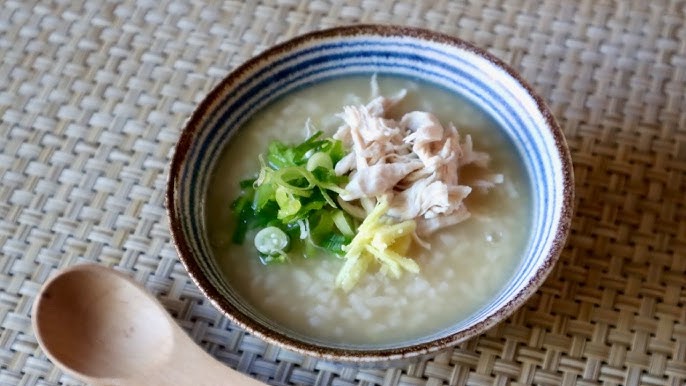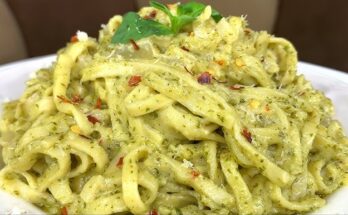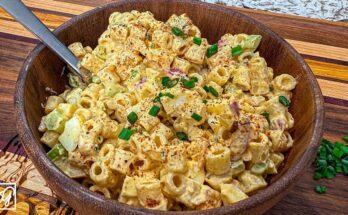Chicken Congee Recipe: Chicken congee is more than just a comforting bowl of rice porridge; it’s a dish that carries centuries of tradition and is loved across many Asian cultures. From Chinese households to Filipino kitchens, congee has always been a go-to meal for breakfast, comfort food when someone is sick, or simply a warm dish to enjoy on a rainy day. It’s simple, nourishing, and endlessly customizable, making it one of the most versatile dishes you can prepare.
What is Congee?
Congee is essentially rice that has been simmered in a large amount of liquid until it breaks down into a creamy, porridge-like consistency. Unlike regular rice, which holds its shape, congee transforms into a silky texture that feels soothing and hearty. Depending on the region, it can be flavored with chicken, pork, seafood, or even just vegetables. Chicken congee, however, stands out because it combines protein-rich chicken with the gentle sweetness of rice, creating a balanced and satisfying meal.
Why Choose Chicken Congee?
Among the different versions of congee, chicken congee is a top favorite because of its simplicity and flavor. It doesn’t require fancy ingredients, yet it delivers a hearty taste that feels like a warm hug in a bowl. The chicken infuses the porridge with richness, while the garnishes like green onions, ginger, and soy sauce add depth. It’s perfect for all ages and can be enjoyed at any time of the day. Plus, it’s easy to digest, which makes it especially comforting when you’re under the weather.
Health Benefits of Chicken Congee
Chicken congee isn’t just delicious—it’s also packed with health benefits. Since it’s made with rice and chicken, you get a combination of carbohydrates for energy and lean protein for strength. The ginger commonly added to congee helps with digestion and has anti-inflammatory properties. Its soft texture makes it gentle on the stomach, making it ideal for kids, seniors, and anyone recovering from illness. Unlike greasy or heavy foods, chicken congee is light yet nourishing, which is why it has stood the test of time as a healing food across cultures.
Ingredients You’ll Need
Making chicken congee requires only a handful of simple ingredients, most of which you probably already have in your pantry. The beauty of this dish is that you can keep it basic or elevate it with garnishes and seasonings to suit your taste.
Main Ingredients
- Rice (1 cup jasmine or short-grain rice) – Jasmine rice gives a slightly fragrant flavor, while short-grain rice yields a creamier texture.
- Chicken (1 whole breast or 2 thighs, bone-in preferred) – The bones add depth to the broth.
- Water or Chicken Stock (8–10 cups) – More liquid gives a silkier consistency.
- Fresh Ginger (2–3 slices) – For warmth and digestion.
- Garlic (2 cloves, minced) – Adds a mild savory note.
- Salt (to taste) – Balances the flavors.
- Pepper (to taste) – For a gentle kick.
Optional Garnishes and Toppings
- Chopped green onions
- Soy sauce or fish sauce
- Sesame oil
- Fried garlic or shallots
- Century egg or salted duck egg
- Cilantro leaves
- Chili oil
These toppings allow you to make your bowl of congee more vibrant and flavorful, giving you the chance to customize each serving.
Substitutions and Alternatives
If you don’t have chicken, you can use turkey or even leftover roast meats. Vegetarians can skip the chicken and replace it with mushrooms or tofu for a hearty alternative. Quinoa or barley can replace rice if you’re looking for something with more fiber, although the flavor and texture will slightly differ. Using pre-made chicken stock instead of water also cuts down cooking time while enhancing the taste.
Preparing the Ingredients
Before you start cooking, a little preparation goes a long way in making your chicken congee come out rich and flavorful.
Selecting the Right Rice
The type of rice you choose will greatly influence the final texture of your congee. Jasmine rice is light and slightly fragrant, giving your congee a subtle aroma. Short-grain rice, like sushi rice, creates a thicker, creamier consistency, which many people prefer. You can even mix both types for the best of both worlds. If you want an extra-smooth congee, rinse the rice thoroughly to remove excess starch before cooking.
Prepping the Chicken
Bone-in chicken pieces, such as thighs or drumsticks, make the broth richer and more flavorful. If you only have boneless chicken breasts, that works too, but you may want to enhance the broth with extra aromatics like onions, ginger, or garlic. Make sure to trim off excess fat or skin if you prefer a lighter broth. Cutting the chicken into smaller pieces makes it easier to shred later when serving.
Washing and Soaking the Rice
Washing rice removes excess starch, preventing your congee from turning overly gummy. Some cooks also soak the rice for 30 minutes before cooking to speed up the breakdown process, especially if they want a smoother consistency. This step is optional, but it helps if you’re in a rush and want the rice to soften faster.
Step-by-Step Cooking Guide
Now that you’ve got your ingredients ready, it’s time to cook. Follow these steps carefully for a perfectly smooth and flavorful chicken congee.
Step 1 – Making the Chicken Broth
Start by placing your chicken pieces in a large pot with 8–10 cups of water or chicken stock. Add a few slices of ginger and let the mixture come to a boil. Skim off any foam that rises to the surface—this ensures a clear, clean broth. Reduce the heat and let it simmer for about 30 minutes until the chicken is fully cooked and the broth is aromatic. Once done, remove the chicken and set it aside for shredding later. Keep the broth simmering.
Step 2 – Cooking the Rice to the Perfect Texture
Add the washed rice into the simmering broth. Stir occasionally to prevent the rice from sticking to the bottom. Let it cook on low heat for about 45 minutes to 1 hour, depending on the consistency you prefer. For a smooth, creamy congee, cook longer and stir more often. If you like a chunkier texture where the rice grains are still visible, reduce the cooking time slightly.
Step 3 – Adding Chicken for Flavor and Nutrition
Shred the cooked chicken into bite-sized pieces and return it to the pot. This not only adds protein but also deepens the flavor of the congee. At this point, you can also add more seasonings like garlic, fish sauce, or a splash of soy sauce to adjust the flavor to your liking.
Step 4 – Seasoning and Simmering
Taste your congee and add salt, pepper, or other seasonings as needed. Let it simmer for another 10–15 minutes to allow the flavors to meld together. If it becomes too thick, add a little more water or stock until you reach your desired consistency.
Step 5 – Serving with Garnishes
Once the congee is ready, ladle it into bowls and top with your favorite garnishes. A drizzle of sesame oil, some chopped green onions, and crispy fried garlic can transform a simple bowl of congee into something restaurant-worthy.
Tips and Tricks for the Best Congee
When cooking congee, small adjustments can make a big difference in the final taste and texture.
Achieving the Right Consistency
Congee can range from thick and creamy to thin and soupy. The trick is adjusting the liquid-to-rice ratio. If you prefer a thicker porridge, use less liquid and cook longer. For a lighter version, simply add more broth toward the end of cooking. Stirring frequently prevents the rice from sticking and ensures a smooth texture.
How to Avoid Overcooking the Chicken
Chicken can easily dry out if cooked for too long. That’s why it’s best to remove it once it’s cooked through, shred it, and then return it toward the end of cooking. This way, it stays tender and juicy instead of tough and stringy.
Flavor Enhancements
A basic chicken congee is delicious on its own, but you can elevate it with small additions. A splash of soy sauce adds umami depth, while sesame oil brings a nutty aroma. Some people like adding a dash of white pepper for subtle heat or even a cracked salted egg for extra richness.
Variations of Chicken Congee
Chicken congee has many regional variations, each bringing its own unique flair. While the basic preparation remains the same—rice cooked into a porridge with chicken—the seasonings, garnishes, and cooking methods vary from culture to culture.
Chinese Style Congee
Chinese chicken congee, or jook, is one of the most popular versions. Traditionally, it is made with jasmine rice and simmered for hours until smooth and creamy. Often flavored with ginger and garlic, Chinese congee is commonly served with toppings like preserved eggs, fried dough sticks (youtiao), and soy sauce. Some families even prepare it plain and let everyone add their own condiments at the table. The comforting, mild flavor makes it a favorite breakfast dish in China, Hong Kong, and Taiwan.
Filipino Arroz Caldo
In the Philippines, chicken congee is known as arroz caldo. This version is heavily seasoned with garlic, ginger, and fish sauce, giving it a bolder, more savory flavor. A key ingredient in arroz caldo is safflower, which gives the dish a distinctive yellow color and subtle aroma. It’s usually topped with boiled eggs, crispy garlic bits, and calamansi (a small citrus fruit) for a tangy finish. Arroz caldo is especially popular during the rainy season and is considered a go-to comfort food for colds and flu.
Thai Jok
Thailand’s version of congee, called jok, is slightly different in texture. The rice is broken down before cooking, resulting in a smoother and almost creamy porridge. Chicken jok is often seasoned with fish sauce, soy sauce, and white pepper. It’s usually topped with a poached egg, fried garlic, ginger strips, and fresh herbs. Many Thai families enjoy jok as a quick breakfast, sometimes even buying it from street vendors who prepare it fresh every morning.
Serving Suggestions
A steaming bowl of chicken congee can stand on its own, but pairing it with the right sides and toppings elevates the experience.
Best Side Dishes to Pair With Chicken Congee
Congee pairs well with both simple and bold-flavored sides. Some great accompaniments include:
- Chinese fried dough sticks (youtiao) – Crispy, chewy, and perfect for dipping.
- Steamed vegetables – Light greens like bok choy or spinach balance the meal.
- Salted duck eggs or century eggs – For a savory and umami-rich boost.
- Pickled vegetables – Provide a tangy contrast to the mild congee.
If you’re preparing congee for a large meal, you can serve it alongside dim sum dishes, dumplings, or steamed buns.
Breakfast vs Dinner Versions
Chicken congee is incredibly versatile—it can be a hearty breakfast or a soothing dinner. For breakfast, keep it simple with chicken, ginger, and a few scallions. This version is light and energizing without being heavy. For dinner, you can make it more filling by adding boiled eggs, fried shallots, and extra chicken, or even serve it alongside fried fish or stir-fried vegetables. Its adaptability is one of the reasons congee remains a staple across cultures.
Storing and Reheating Congee
One of the best things about chicken congee is that it keeps well, making it perfect for meal prep. However, storing and reheating it properly ensures you maintain its creamy consistency and flavor.
Refrigerator Storage Tips
Allow the congee to cool before transferring it to an airtight container. It can be stored in the refrigerator for up to 3–4 days. Since rice tends to absorb more liquid as it sits, the congee may thicken after chilling. Don’t worry—this is completely normal and can be fixed during reheating.
Freezing Congee for Later
Congee freezes surprisingly well. Store it in freezer-safe containers or portion it into resealable bags for convenience. When properly stored, it can last for up to 2 months in the freezer. To reheat, thaw it overnight in the refrigerator before warming it up.
Reheating Without Losing Flavor
When reheating congee, always add a splash of water or broth to loosen the consistency. Heat it gently on the stovetop, stirring frequently to prevent sticking. If you’re in a hurry, you can also reheat it in the microwave, but stir halfway through to ensure even heating. Re-season with soy sauce, fish sauce, or fresh garnishes to bring back its full flavor.
Common Mistakes to Avoid
Even though chicken congee is a relatively simple dish, a few mistakes can affect the outcome. Here are the most common ones and how to avoid them.
Using the Wrong Rice
Not all rice is created equal when it comes to congee. Long-grain rice tends to stay too firm and doesn’t break down easily. Short-grain or jasmine rice is the best choice for a creamy consistency. Mixing rice types can also give you an interesting texture, but avoid using parboiled or instant rice, as they won’t yield the right results.
Overseasoning or Underseasoning
Congee is naturally mild, so it needs a good balance of seasoning. Too little, and it tastes bland; too much, and you overpower the subtle flavors of the rice and chicken. The trick is to season gradually—start light, taste often, and adjust as needed. Remember, garnishes like soy sauce, fish sauce, and chili oil will also add extra flavor at the end.
Skipping the Broth Step
Some people try to cook rice directly in water without making a broth first. While this is quicker, it often results in a flat-tasting congee. Simmering chicken with ginger and garlic before adding the rice builds a flavorful base that makes all the difference. If you’re pressed for time, you can use ready-made chicken stock, but a homemade broth always tastes better.
FAQs about Chicken Congee Recipe
1. Can I make chicken congee in a slow cooker?
Yes! Simply add rice, chicken, water or broth, ginger, and garlic into the slow cooker. Cook on low for 6–8 hours or high for 3–4 hours. Shred the chicken before serving.
2. What rice works best for congee?
Jasmine rice and short-grain rice are the best options. They break down nicely, creating a creamy and smooth porridge.
3. Can I use leftover rotisserie chicken?
Absolutely. Add shredded rotisserie chicken during the last 10 minutes of cooking. Since it’s already cooked, you don’t want to simmer it for too long.
4. How do I make congee vegetarian?
Replace the chicken with mushrooms, tofu, or vegetables, and use vegetable broth instead of chicken stock. The result is just as hearty and flavorful.
5. Is chicken congee suitable for kids?
Yes, it’s a great meal for kids. Its soft texture makes it easy to eat, and you can keep the seasoning mild to suit their taste.
Conclusion
Chicken congee is a timeless dish that combines simplicity with comfort. Whether you’re looking for a nourishing breakfast, a comforting dinner, or a soothing meal when you’re feeling under the weather, chicken congee delivers every time. Its versatility allows you to customize it with toppings, pair it with side dishes, or even adapt it to different cultural styles like Chinese jook, Filipino arroz caldo, or Thai jok. With just rice, chicken, and a few seasonings, you can create a bowl of warmth and flavor that never disappoints.



